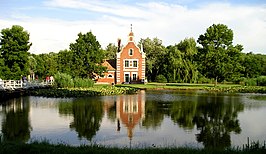Fejér county
|
Fejér County Fejér megye (Hungarian) |
|||||
|---|---|---|---|---|---|
| Counties of Hungary | |||||
Descending, from top: the Holland House in the park of the Festetich Palace in Dég, Martonvásár area, arboretum in Alcsútdoboz in the Duna-Ipoly National Park
|
|||||
|
|||||
 |
|||||
| Country | Hungary | ||||
| Region | Central Transdanubia | ||||
| County seat | Székesfehérvár | ||||
| Government | |||||
| • President of the General Assembly | Dr. Krisztián Molnár (Fidesz-KDNP) | ||||
| Area | |||||
| • Total | 4,358.45 km2 (1,682.81 sq mi) | ||||
| Area rank | 11th in Hungary | ||||
| Population (2011 census) | |||||
| • Total | 425,847 | ||||
| • Rank | 7th in Hungary | ||||
| • Density | 98/km2 (250/sq mi) | ||||
| Postal code | 206x, 209x, 24xx, 700x – 701x, 7041, 80xx, 811x – 815x |
||||
| Area code(s) | (+36) 22, 25 | ||||
| ISO 3166 code | HU-FE | ||||
| Website | www |
||||
Fejér (Hungarian pronunciation: [ˈfɛjeːr]) is an administrative county (comitatus or megye) in Central Hungary. It lies on the west bank of the river Danube and nearly touches the eastern shore of Lake Balaton. It shares borders with the Hungarian counties Veszprém, Komárom-Esztergom, Pest, Bács-Kiskun, Tolna and Somogy. The capital of Fejér county is Székesfehérvár.
Geographically, Fejér County is very diverse; its southern part is similar (and adjacent) to the Great Hungarian Plain, and other parts are hilly (Bakony, Vértes, Gerecse mountains). Lake Velence, a popular resort, is also located there.
The area was already inhabited 20,000 years ago. When this part of Hungary formed a Roman province called Pannonia, several settlements stood here: the capital was Gorsium, but there were other significant towns too, where present-day Baracs and Dunaújváros are (the towns were called Annamatia and Intercisa, respectively). In the early Medieval period Huns and Avars lived in the area. After 586 several nomadic people inhabited in the area, until Hungarians conquered it in the late 9th century.
Hungarians arrived in the area between 895 and 900. The high prince and his tribe settled down in this area. The town of Fehérvár (modern-day Székesfehérvár) became significant as the seat of Prince Géza. Under the reign of his son, King Stephen, the town became the county seat of the newly formed county. Kings of Hungary were crowned and buried in the town until the 16th century.
...
Wikipedia





